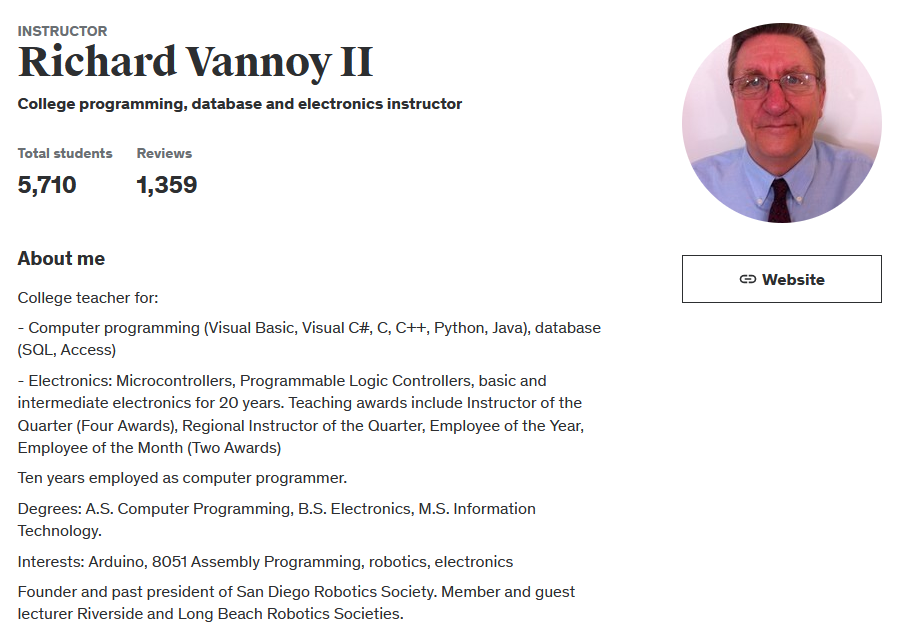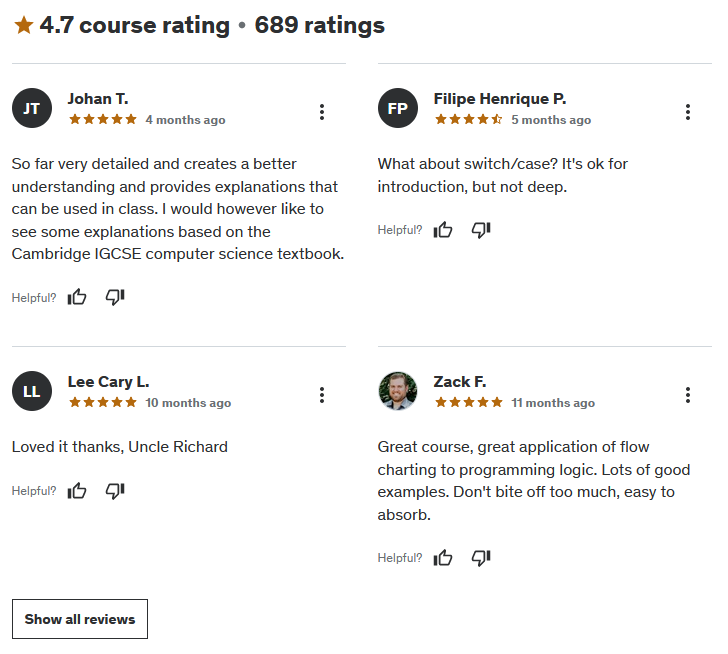Hey everyone!
I recently wrapped up the Udemy course “Learn Flowcharting and Pseudocode. Be a better programmer!” and thought I’d share my take on it. Whether you’re just stepping into the world of programming or you’ve been around the block but haven’t dabbled in flowcharting or pseudocode, this course might just be what you need to simplify your coding journey.
First off, the course promises to arm you with two of the most crucial skills in a programmer’s toolkit: pseudocode and flowcharts. And let me tell you, it delivers. It’s designed to ease your learning curve across any programming language, which is a pretty tall order, but one that Richard Vannoy, the course instructor, manages to fulfill.
Instructor Reputation
When it comes to online courses, the instructor can make or break the experience. In the case of “Learn Flowcharting and Pseudocode. Be a better programmer!” Richard Vannoy II isn’t just making the experience; he’s elevating it. With a robust background that spans over two and a half decades of teaching programming at the college level, Richard brings a wealth of knowledge and experience to the table. But what does that really mean for you as a student in his course?

First off, Richard’s experience isn’t just theoretical. Before stepping into the world of academia, he spent ten years in the trenches as a computer programmer. This blend of real-world experience and academic knowledge is a goldmine for students. Why? Because it means you’re not just learning concepts in a vacuum. Richard understands the challenges programmers face daily and has tailored his course to address these challenges head-on.
Moreover, his academic credentials are just as impressive, holding degrees in Computer Programming, Electronics, and Information Technology. This multidisciplinary background enriches the course content, making it well-rounded and applicable across various fields.
But credentials alone don’t paint the full picture. The real testament to Richard’s prowess as an instructor comes from his students. With a 4.5 instructor rating garnered from over 1,359 reviews, it’s clear that students appreciate his teaching style. Reviews highlight his ability to break down complex concepts into understandable segments, his responsiveness to student queries, and the practical applicability of the course content.
Beyond the numbers, Richard’s awards for teaching excellence, including Instructor of the Quarter and Employee of the Year, underscore his commitment to teaching and his ability to connect with students. His passion for subjects like Arduino, robotics, and programming not only makes the course engaging but also inspires students to explore these areas further.
In summary, Richard Vannoy’s reputation as an instructor is built on a solid foundation of professional experience, academic credentials, and a genuine passion for teaching. His approach to this course reflects a deep understanding of the learning process, making complex topics accessible and engaging for students at all levels.
Course Structure
The structure of “Learn Flowcharting and Pseudocode. Be a better programmer!” is meticulously designed to cater to learners of all backgrounds, especially those new to programming or seeking to solidify their understanding of fundamental concepts. Here’s a deeper look into how the course is structured and what makes it effective.

At the heart of the course’s structure are the video sessions. These aren’t your run-of-the-mill lecture videos; they’re carefully crafted presentations that range from 10 to 20 minutes. This deliberate choice to keep videos concise addresses one of the biggest challenges in online learning: maintaining student engagement. By breaking down the content into digestible chunks, Richard ensures that students can easily fit learning into their schedules without feeling overwhelmed.
These video sessions are complemented by exercises that challenge you to apply what you’ve learned. This hands-on approach is crucial for solidifying the concepts covered in the videos. The exercises come with answers, providing immediate feedback and a way to assess your understanding. This iterative learning process, where you’re introduced to a concept and then apply it, helps in cementing your knowledge.
Moreover, the course includes several handouts that supplement the lectures. These handouts serve as valuable resources for students, offering summaries of key points and additional information that can be referred to at any time. This material is especially useful for revising concepts or for use as a quick reference while working on programming projects.
Another noteworthy aspect of the course structure is the instructor’s commitment to student interaction. Richard’s promise to answer questions promptly, usually within 24 hours, adds a layer of support that is often missing in online courses. This responsiveness not only enhances the learning experience but also builds a sense of community and engagement among students.
Lastly, the course’s structure is inclusive, requiring no prerequisite knowledge and suggesting tools that are either free or affordable. This inclusivity ensures that financial barriers do not hinder learning, making the course accessible to a wide audience.
In conclusion, the course structure is a testament to thoughtful instructional design. It balances theoretical knowledge with practical application, engages students through concise and informative video sessions, supports learning with supplemental materials and exercises, and fosters a supportive learning environment through active instructor engagement. This comprehensive approach not only makes the course accessible to beginners but also enriches the learning experience for all students.
Content Quality
The “Learn Flowcharting and Pseudocode. Be a better programmer!” course sets itself apart with its content quality. It’s clear from the get-go that this course is meticulously planned to provide a thorough grounding in essential programming tools. Let’s dive deeper into what makes the content stand out.

First and foremost, the course zeroes in on pseudocode and flowcharts, two tools that are pivotal for programmers yet often overlooked in traditional programming education. Pseudocode, with its simplified approach to outlining algorithms without the syntax complexities of specific programming languages, and flowcharts, which visually map out the process flow, are invaluable for both novice and experienced programmers. This focus ensures that learners grasp the fundamentals of programming logic and structure before diving into code, a step that can significantly improve programming efficiency and effectiveness.
The content is delivered in a manner that is both comprehensive and comprehensible. Richard Vannoy does an exceptional job of breaking down these complex topics into understandable segments. For beginners, this approach demystifies programming and builds confidence. For those with some programming background, the course offers a new perspective on planning and problem-solving that can enhance their coding practices.
Moreover, the course is designed to be generic, not tied to any specific programming language. This universality is a strength, making the skills learned applicable across a wide array of programming tasks and languages, from Java and Python to C++ and beyond. It emphasizes the transferability of the skills taught, ensuring that students can apply what they’ve learned regardless of their preferred programming language.
The inclusion of exercises and handouts further enriches the content. These resources allow students to practice and apply what they’ve learned, reinforcing the course material and ensuring that knowledge is not just passively received but actively understood and remembered. The exercises, in particular, are well-crafted, offering students the chance to tackle real-world problems using the tools they’ve learned.
Finally, the course benefits from Richard’s clear and engaging teaching style. His ability to explain complex concepts in simple terms, combined with his practical insights into programming, ensures that the content is not just high quality but also engaging and relevant.
Overall Course Rating – 9/10
Taking everything into account—the depth and clarity of the content, the structure of the course, the instructor’s expertise and engagement, and the practical exercises—I would rate “Learn Flowcharting and Pseudocode. Be a better programmer!” a solid 9 out of 10.

Why not a perfect score? While the course excels in many areas, there’s always room for improvement. Some students have noted that the pace could be faster, suggesting that more advanced topics could be included without sacrificing clarity. Additionally, incorporating more interactive elements or live coding sessions could enhance the learning experience by providing more dynamic ways to engage with the material.
However, these are minor critiques in the grand scheme of things. The course’s strengths far outweigh its limitations. Its focus on fundamental programming tools, its accessibility to beginners, and its applicability to a wide range of programming languages make it an invaluable resource for anyone looking to enhance their programming skills. The quality of the content, combined with Richard Vannoy’s effective teaching methods, makes this a standout course that delivers on its promises.
In conclusion, whether you’re new to programming or looking to refine your approach to planning and problem-solving in coding, this course offers valuable insights and skills that can benefit your programming journey. Its comprehensive content, practical exercises, and the supportive learning environment facilitated by an experienced and engaging instructor earn it a high rating and my hearty recommendation.
So, if you’re on the fence about taking the plunge, I’d say go for it. The skills you’ll pick up are foundational, transcending any specific programming language and potentially saving you heaps of time and frustration down the line.
Happy coding, folks!



